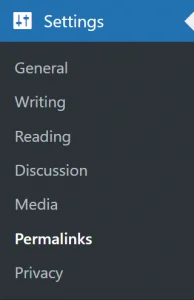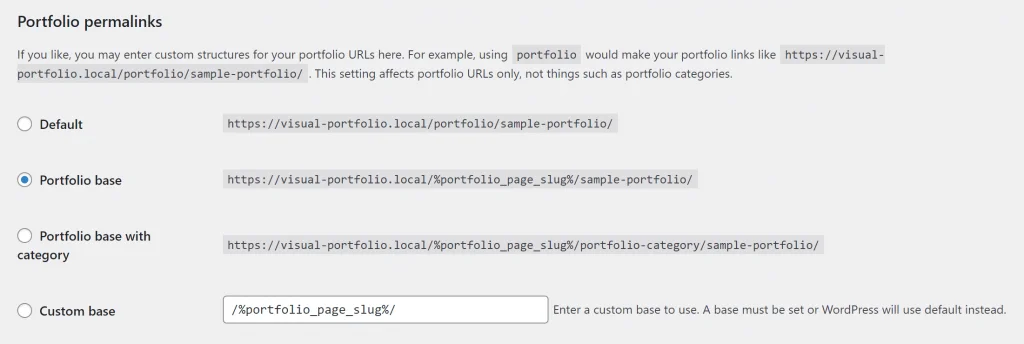Table of Contents
Permalink is short for “permanent link”. Permalinks are permanent URL structures used to help organize the content of your website (pages, posts, portfolio, etc.) so it can be efficiently navigated, shared, and referenced by users and bots.
Permalink settings for Visual Portfolio can be found at WordPress → Settings → Permalinks.

From here you can configure the URL structure for your Portfolio Taxonomies and Portfolio Projects pages.
For best practice, permalink structures should contain keywords relating to the content they help categorize.
Taxonomy Permalinks
There are two settings at WordPress → Settings → Permalinks → Optional that control the base of your categories and tags on Visual Portfolio:

- Portfolio category base – The default portfolio category base is portfolio-category. An example would be
yourdomain.com/portfolio-category/category-name. - Portfolio tag base – The default portfolio tag base is portfolio-tag. An example would be
yourdomain.com/portfolio-tag/tag-name.
Project Permalinks
There are four settings under WordPress → Settings → Permalinks → Portfolio Permalinks to select from as your permalink base for projects:

- Default – If you are not using pretty permalinks, Default will be the only option available to you and will use ID-based URLs. An example would be
yourdomain.com/?portfolio=111. If you are using pretty permalinks, the portfolio base will beyourdomain.com/portfolio/work-name. - Portfolio base – The portfolio base will use the portfolio archive page name. An example would be
yourdomain.com/works/work-name. - Portfolio base with category – The portfolio base with category will use the portfolio archive page name first, then add the portfolio category name. An example would be
yourdomain.com/works/portfolio-category-name/work-name. - Custom base – The custom base will allow you to set custom text before the project name. An example would be
yourdomain.com/custom-text/work-name.
Note: the %portfolio_page_slug% short tag will automatically use the Portfolio Archive page slug.
Note: The portfolio Custom base setting should NOT conflict with the Taxonomy permalink settings. If you set the portfolio base to portfolio, for example, you should NOT set the portfolio category base to portfolio too, as this will not be unique and cause a conflict. WordPress requires something unique so it can distinguish categories from projects.
Portfolio Archive Permalink
The archive page permalink will be automatically loaded from your archive page slug. Read more info about Portfolio Archive page here:
Removing /portfolio/ , /portfolio-category/ , or /portfolio-tag/ from the URLs
Removing /portfolio/, /portfolio-category/, or /portfolio-tag/ from the URLs is not advisable due to the way WordPress resolves its URLs. It uses the portfolio-category (or any other text for that matter) base of an URL to detect that it is an URL leading to a portfolio category.
There are SEO plugins that allow you to remove this base, but that can lead to a number of problems with performance and duplicate URLs.
You will make it harder for WordPress to detect what page you are trying to reach when you type in a portfolio category URL.
Also, understand that the standard “Page” in WordPress always has no base text in the URL. For example:
https://yoursite.com/about-page/(this is the URL of a standard page)https://yoursite.com/about-page/portfolio-category/category-x/(this is the URL leading to a portfolio category)
What would happen if we remove that portfolio-category part?
https://yoursite.com/about-page/about-page/https://yoursite.com/about-page/category-x/
WordPress will have to do much more work to detect what page you are looking for when entering one of the above URLs. That is why we do not recommend using any SEO plugin to achieve this.
 Introduction
Introduction Archive
Archive Projects
Projects Gallery Blocks
Gallery Blocks Social Feeds
Social Feeds Proofing
Proofing Saved Layouts and Shortcodes
Saved Layouts and Shortcodes Settings
Settings FAQ
FAQ Troubleshooting
Troubleshooting Developers
Developers